2020 Hyundai Ioniq Hybrid fuel
[x] Cancel search: fuelPage 567 of 635
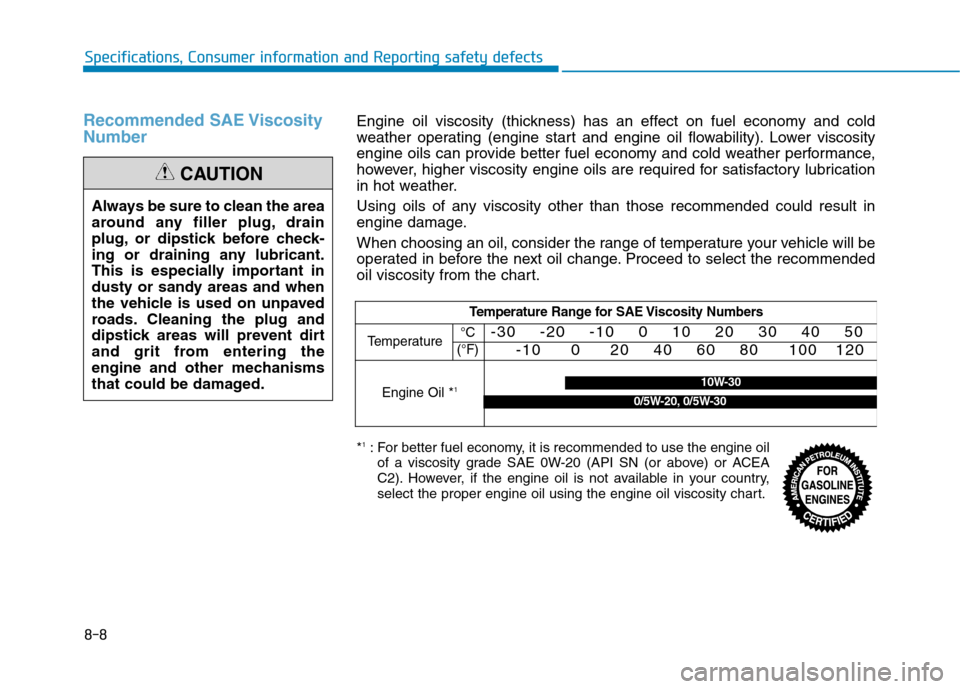
8-8
Specifications, Consumer information and Reporting safety defects
Recommended SAE Viscosity
Number
Always be sure to clean the area
around any filler plug, drain
plug, or dipstick before check-
ing or draining any lubricant.
This is especially important in
dusty or sandy areas and when
the vehicle is used on unpaved
roads. Cleaning the plug and
dipstick areas will prevent dirt
and grit from entering the
engine and other mechanisms
that could be damaged.
CAUTION
Temperature Range for SAE Viscosity Numbers
Temperature -30 -20 -10 0 10 20 30 40 50
-10 0 20 40 60 80 100 120
Engine Oil *1
°C
(°F)
*1: For better fuel economy, it is recommended to use the engine oil
of a viscosity grade SAE 0W-20 (API SN (or above) or ACEA
C2). However, if the engine oil is not available in your country,
select the proper engine oil using the engine oil viscosity chart.
10W-30
0/5W-20, 0/5W-30
Engine oil viscosity (thickness) has an effect on fuel economy and cold
weather operating (engine start and engine oil flowability). Lower viscosity
engine oils can provide better fuel economy and cold weather performance,
however, higher viscosity engine oils are required for satisfactory lubrication
in hot weather.
Using oils of any viscosity other than those recommended could result in
engine damage.
When choosing an oil, consider the range of temperature your vehicle will be
operated in before the next oil change. Proceed to select the recommended
oil viscosity from the chart.
Page 573 of 635
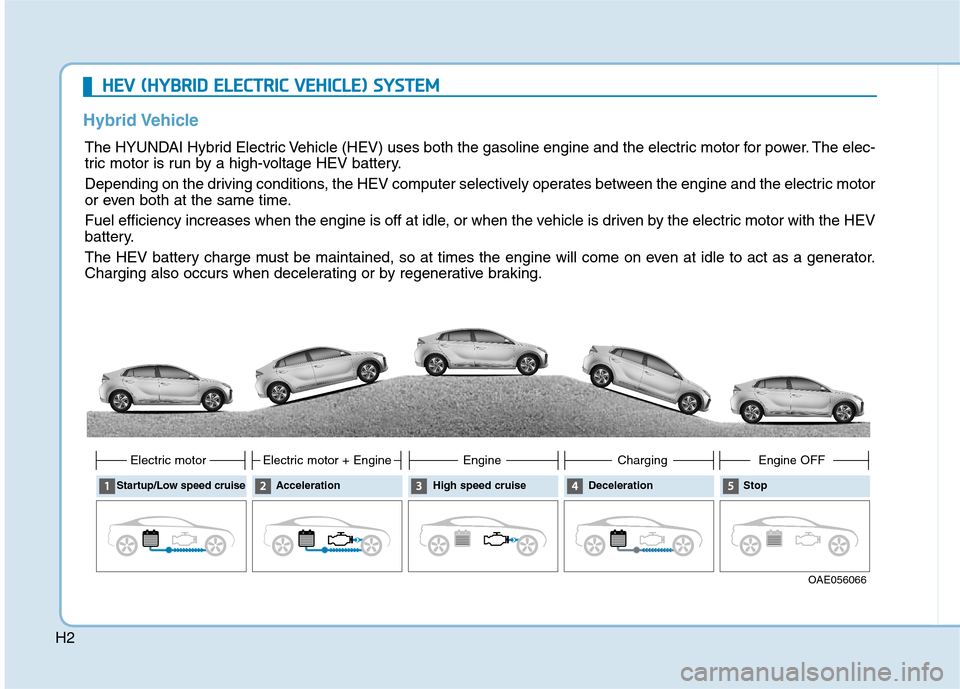
H2
Hybrid Vehicle H HE
EV
V
(
(H
HY
YB
BR
RI
ID
D
E
EL
LE
EC
CT
TR
RI
IC
C
V
VE
EH
HI
IC
CL
LE
E)
)
S
SY
YS
ST
TE
EM
M
The HYUNDAI Hybrid Electric Vehicle (HEV) uses both the gasoline engine and the electric motor for power. The elec-
tric motor is run by a high-voltage HEV battery.
Depending on the driving conditions, the HEV computer selectively operates between the engine and the electric motor
or even both at the same time.
Fuel efficiency increases when the engine is off at idle, or when the vehicle is driven by the electric motor with the HEV
battery.
The HEV battery charge must be maintained, so at times the engine will come on even at idle to act as a generator.
Charging also occurs when decelerating or by regenerative braking.
OAE056066 Startup/Low speed cruise
Electric motor
Acceleration
Electric motor + Engine
High speed cruise
Engine
Deceleration
Charging
Stop
Engine OFF
Page 602 of 635
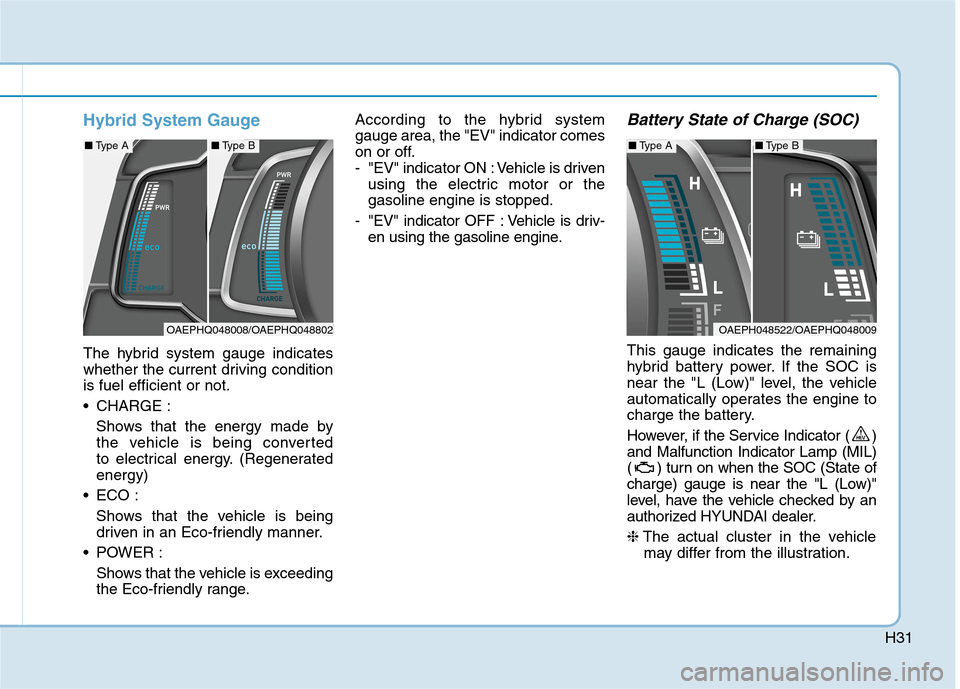
H31
Hybrid System Gauge
The hybrid system gauge indicates
whether the current driving condition
is fuel efficient or not.
CHARGE :
Shows that the energy made by
the vehicle is being converted
to electrical energy. (Regenerated
energy)
ECO :
Shows that the vehicle is being
driven in an Eco-friendly manner.
POWER :
Shows that the vehicle is exceeding
the Eco-friendly range.According to the hybrid system
gauge area, the "EV" indicator comes
on or off.
- "EV" indicator ON : Vehicle is driven
using the electric motor or the
gasoline engine is stopped.
- "EV" indicator OFF : Vehicle is driv-
en using the gasoline engine.
Battery State of Charge (SOC)
This gauge indicates the remaining
hybrid battery power. If the SOC is
near the "L (Low)" level, the vehicle
automatically operates the engine to
charge the battery.
However, if the Service Indicator ( )
and Malfunction Indicator Lamp (MIL)
( ) turn on when the SOC (State of
charge) gauge is near the "L (Low)"
level, have the vehicle checked by an
authorized HYUNDAI dealer.
❈The actual cluster in the vehicle
may differ from the illustration.
OAEPHQ048008/OAEPHQ048802
■Type A■Type B
OAEPH048522/OAEPHQ048009
■Type A■Type B
Page 609 of 635
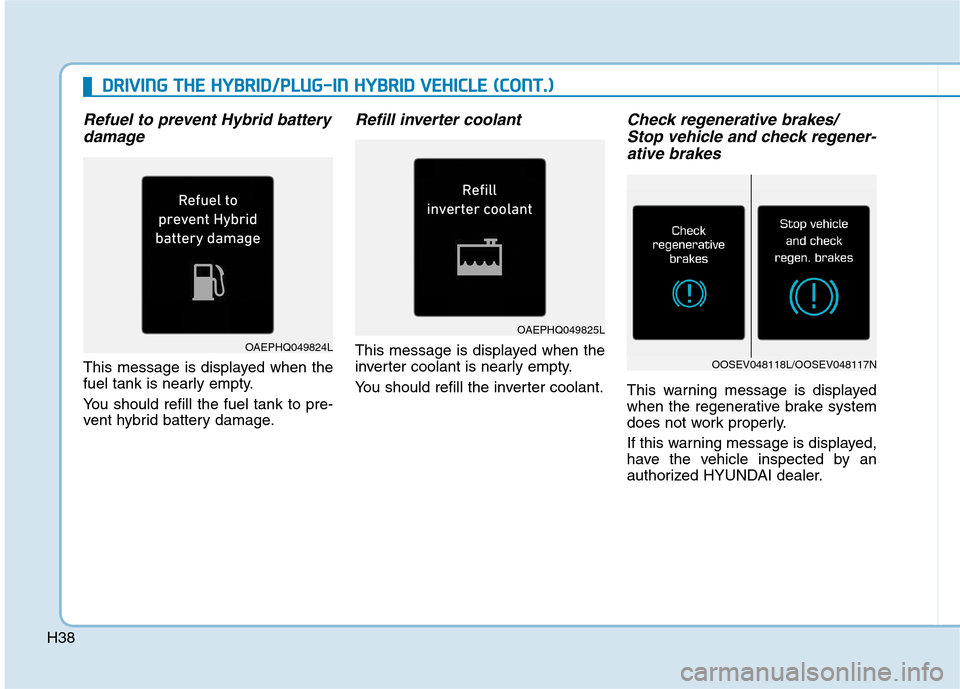
H38
D DR
RI
IV
VI
IN
NG
G
T
TH
HE
E
H
HY
YB
BR
RI
ID
D/
/P
PL
LU
UG
G-
-I
IN
N
H
HY
YB
BR
RI
ID
D
V
VE
EH
HI
IC
CL
LE
E
(
(C
CO
ON
NT
T.
.)
)
Refuel to prevent Hybrid battery
damage
This message is displayed when the
fuel tank is nearly empty.
You should refill the fuel tank to pre-
vent hybrid battery damage.
Refill inverter coolant
This message is displayed when the
inverter coolant is nearly empty.
You should refill the inverter coolant.
Check regenerative brakes/
Stop vehicle and check regener-
ative brakes
This warning message is displayed
when the regenerative brake system
does not work properly.
If this warning message is displayed,
have the vehicle inspected by an
authorized HYUNDAI dealer.
OAEPHQ049824L
OAEPHQ049825L
OOSEV048118L/OOSEV048117N
Page 612 of 635

H41
Wait until fuel door opens
(Plug-in hybrid vehicle)
This message is displayed when you
attempt to open the fuel filler door
with the fuel tank pressurized. Wait
until the fuel tank is depressurized.
Information
It may take up to 20 seconds to open
fuel filler door.
Check fuel door (Plug-in hybrid)
This message is displayed when
there is a problem with the fuel filler
door. Such as, when the fuel filler
door does not open after 20 seconds
at freezing temperature.
Information
When the fuel filler door is frozen and
does not open after 20 seconds at
freezing temperature, slightly tap the
fuel filler door and then attempt to
open it. In other cases, have your vehi-
cle inspected by an authorized
HYUNDAI dealer.
Fuel door open
(Plug-in hybrid vehicle)
This message is displayed when the
fuel filler door opens after the fuel
tank is depressurized. If this mes-
sage is displayed, you can refuel the
fuel tank.
ii
OAEPHQ049830L
OAEPHQ049831L
OAEPHQ049832L
Page 613 of 635
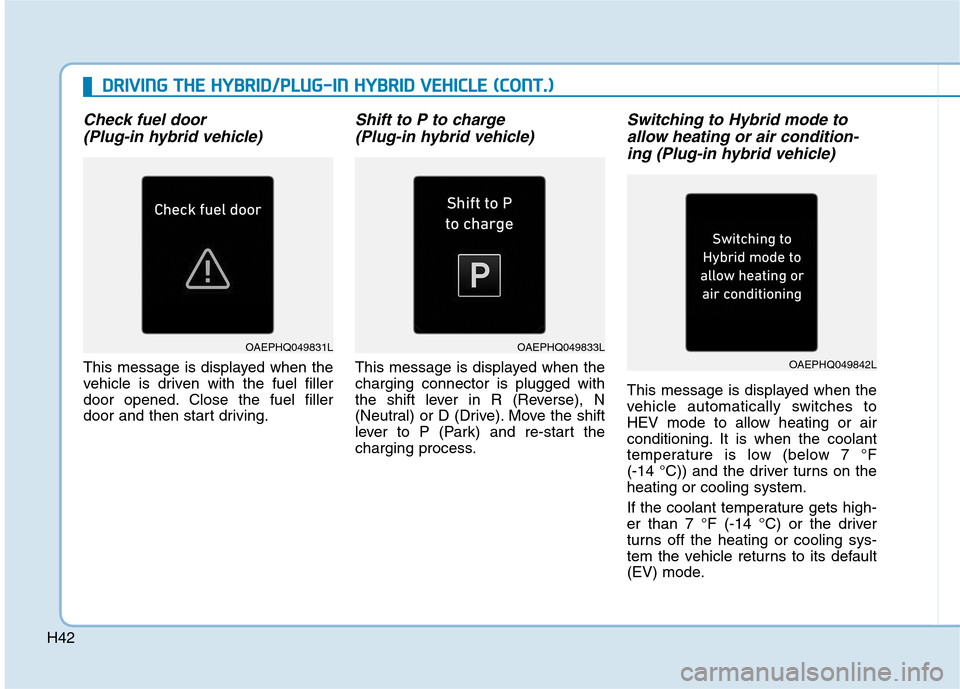
H42
D DR
RI
IV
VI
IN
NG
G
T
TH
HE
E
H
HY
YB
BR
RI
ID
D/
/P
PL
LU
UG
G-
-I
IN
N
H
HY
YB
BR
RI
ID
D
V
VE
EH
HI
IC
CL
LE
E
(
(C
CO
ON
NT
T.
.)
)
Check fuel door
(Plug-in hybrid vehicle)
This message is displayed when the
vehicle is driven with the fuel filler
door opened. Close the fuel filler
door and then start driving.
Shift to P to charge
(Plug-in hybrid vehicle)
This message is displayed when the
charging connector is plugged with
the shift lever in R (Reverse), N
(Neutral) or D (Drive). Move the shift
lever to P (Park) and re-start the
charging process.
Switching to Hybrid mode to
allow heating or air condition-
ing (Plug-in hybrid vehicle)
This message is displayed when the
vehicle automatically switches to
HEV mode to allow heating or air
conditioning. It is when the coolant
temperature is low (below 7 °F
(-14 °C)) and the driver turns on the
heating or cooling system.
If the coolant temperature gets high-
er than 7 °F (-14 °C) or the driver
turns off the heating or cooling sys-
tem the vehicle returns to its default
(EV) mode.
OAEPHQ049831LOAEPHQ049833L
OAEPHQ049842L
Page 626 of 635
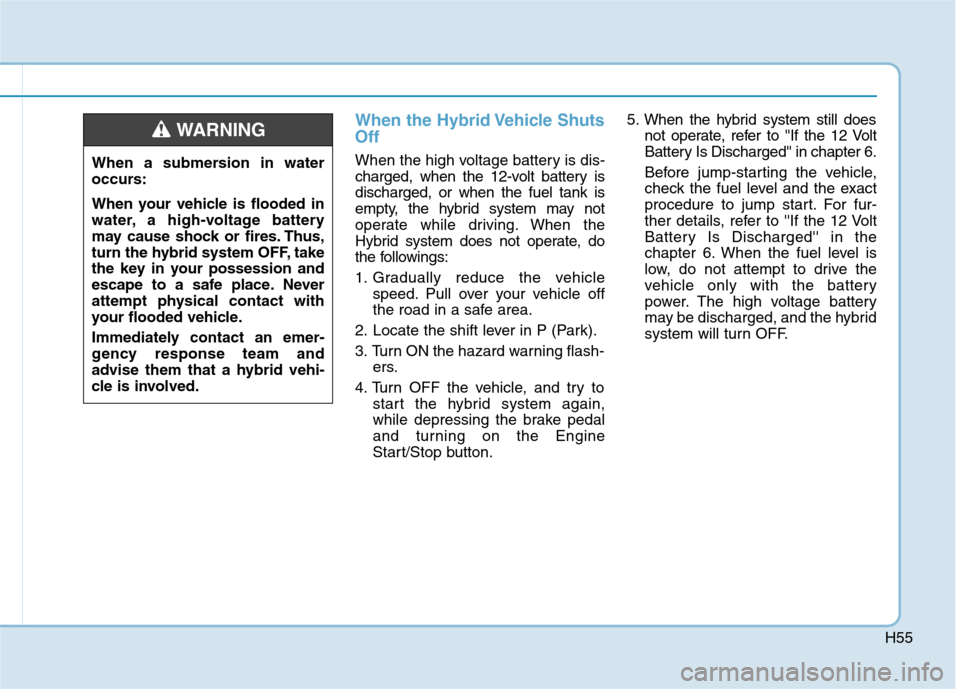
H55
When the Hybrid Vehicle Shuts
Off
When the high voltage battery is dis-
charged, when the 12-volt battery is
discharged, or when the fuel tank is
empty, the hybrid system may not
operate while driving. When the
Hybrid system does not operate, do
the followings:
1. Gradually reduce the vehicle
speed. Pull over your vehicle off
the road in a safe area.
2. Locate the shift lever in P (Park).
3. Turn ON the hazard warning flash-
ers.
4. Turn OFF the vehicle, and try to
start the hybrid system again,
while depressing the brake pedal
and turning on the Engine
Start/Stop button.5. When the hybrid system still does
not operate, refer to ''If the 12 Volt
Battery Is Discharged'' in chapter 6.
Before jump-starting the vehicle,
check the fuel level and the exact
procedure to jump start. For fur-
ther details, refer to ''If the 12 Volt
Battery Is Discharged'' in the
chapter 6. When the fuel level is
low, do not attempt to drive the
vehicle only with the battery
power. The high voltage battery
may be discharged, and the hybrid
system will turn OFF. When a submersion in water
occurs:
When your vehicle is flooded in
water, a high-voltage battery
may cause shock or fires. Thus,
turn the hybrid system OFF, take
the key in your possession and
escape to a safe place. Never
attempt physical contact with
your flooded vehicle.
Immediately contact an emer-
gency response team and
advise them that a hybrid vehi-
cle is involved.
WARNING
Page 629 of 635

I-3
California perchlorate notice ..........................................7-79
Child Restraint System (CRS) ........................................2-36
Children Always in the Rear ......................................2-36
Installing a Child Restraint System (CRS) ................2-39
Selecting a Child Restraint System (CRS).................2-37
Climate control additional features...............................3-159
Automatic Ventilation .............................................3-159
Sunroof inside air recirculation ................................3-159
Climate control air filter .................................................7-26
Filter inspection ..........................................................7-26
Coasting guide ...............................................................5-25
Consumer information ....................................................8-11
Cruise control ...............................................................5-107
Cruise Control operation ..........................................5-107
Dimensions .......................................................................8-2
Door locks .........................................................................3-9
Auto Door Lock/Unlock Features ..............................3-12
Child-Protector Rear Door Locks ..............................3-12
Operating Door Locks from Inside the Vehicle ........3-10
Operating Door Locks from Outside the Vehicle .......3-9
Driver Attention Warning (DAW) ..................................5-99
Leading Vehicle Departure Alert .............................5-105
Resetting the system ................................................5-102System malfunction ..................................................5-102
System setting and operation .....................................5-99
System standby.........................................................5-102
Driver position memory system ....................................3-14
Easy Access Function .................................................3-15
Recalling Positions from Memory .............................3-15
Storing Positions into Memory .................................3-14
Dual clutch transmission.................................................5-12
Dual Clutch Transmission Operation .........................5-12
Good Driving Practices .............................................5-20
LCD display for transmission temperature and
warning message ......................................................5-14
Parking........................................................................5-19
Shift Lever Position....................................................5-16
Emission control system .................................................7-75
Crankcase Emission Control System .........................7-76
Evaporative Emission Control System Including
Onboard Refueling Vapor Recovery (ORVR) .........7-76
Exhaust Emission Control System .............................7-76
Engine ...............................................................................8-2
Engine compartment .........................................................7-3
Engine coolant/inverter coolant ......................................7-18
Changing Coolant.......................................................7-21
Checking the Coolant Level .......................................7-18
Engine number ................................................................8-10
I
Index
C
D
E